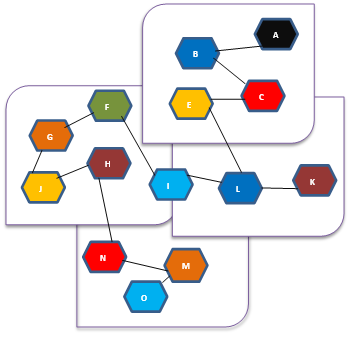Anomaly Recognition in Wireless Ad-hoc Network by using Ant Colony Optimization and Deep Learning
Main Article Content
Abstract
As a result of lower initial investment, greater portability, and lower operational expenses, wireless networks are rapidly replacing their wired counterparts. The new technology that is on the rise is the Mobile Ad-Hoc Network (MANET), which operates without a fixed network infrastructure, can change its topology on the fly, and requires no centralised administration to manage its individual nodes. As a result, MANETs must focus on network efficiency and safety. It is crucial in MANET to pay attention to outliers that may affect QoS settings. Nonetheless, despite the numerous studies devoted to anomaly detection in MANET, security breaches and performance difficulties keep coming back. There is an increased need to provide strategies and approaches that help networks be more safe and robust due to the wide variety of security and performance challenges in MANET. This study presents outlier detection strategies for addressing security and performance challenges in MANET, with a special focus on network anomaly identification. The suggested work utilises a dynamic threshold and outlier detection to tackle the security and performance challenges in MANETs, taking into account metrics such as end-to-end delay, jitter, throughput, packet drop, and energy usage.
Article Details
References
V. Justin, N. Marathe, and N. Dongre, “Hybrid IDS using SVM classifier for detecting DoS attack in MANET application,” in 2017 International Conference on I-SMAC (IoT in Social, Mobile, Analytics and Cloud) (I-SMAC), 2017.
M. Reza and S. Abyaneh, “Security analysis of Lightweight Schemes for RFID Systems,” 2012.
S. Parthasarathy, “Extraction of Outliers from Imbalanced Sets,” pp. 2167–2172, 2016.
K. D. Sharma, Aayush, S. Abhishek, and J. Kumar, “KNNR: K-nearest neighbour classification based routing protocol for opportunistic networks,” in 2017 Tenth International Conference on Contemporary Computing (IC3), 2017.
O. Yim, “Hierarchical Cluster Analysis: Comparison of Three Linkage Measures and Application to Psychological Data,” Quant. methods Psychol., pp. 8–21, 2015.
M. J. Embrechts, C. J. Gatti, J. Linton, and B. Roysam, Hierarchical Clustering for Large Data Sets. 2013.
J. Hussain and S. Lalmuanawma, “Fusion of Misuse Detection with Anomaly Detection Technique for Novel Hybrid Network Intrusion Detection System,” in Recent Developments in Intelligent Computing, Communication and Devices, 2017, pp. 73–87.
G. Pu, L. Wang, J. Shen, and F. Dong, “A Hybrid Unsupervised Clustering-Based Anomaly Detection Method,” Tsinghua Sci. Technol., vol. 26, no. 2, pp. 146–153, 2020.
V. Rishiwal, S. Verma, and S. K. Bajpai, “QoS Based Power Aware Routing in MANETs,” Int. J. Comput. Theory Eng., vol. 1, no. 1, pp. 49–54, 2013.
V. Rishiwal, S. K. Agarwal, and M. Yadav, “Performance of AODV protocol for H-MANETs,” Proc. - 2016 Int. Conf. Adv. Comput. Commun. Autom. ICACCA 2016, pp. 1–4, 2016.
O. A. Osanaiye, A. S. Alfa, and G. P. Hancke, “Denial of Service Defence for Resource Availability in Wireless Sensor Networks,” IEEE Access, vol. 6, pp.6975–7004, 2018.
J. Karlsson, G. Pulkkis, and L. S. Dooley, “A packet traversal time per hop based adaptive wormhole detection algorithm for MANETs,” 2016 24th Int. Conf. Software, Telecommun. Comput. Networks, SoftCOM 2016, 2016.
S. Yadav, M. C. Trivedi, V. K. Singh, and M. L. Kolhe, “Securing AODV routing protocol against black hole attack in MANET using outlier detection scheme,” 2017 4th IEEE Uttar Pradesh Sect. Int. Conf. Electr. Comput. Electron. UPCON 2017, vol. 2018–Janua, pp. 1–4, 2018.
A. Kumar, K. Gopal, and A. Aggarwal, “Design and analysis of lightweight trust mechanism for secret data using lightweight cryptographic primitives in MANETs,” Int. J. Netw. Secur., vol. 18, no. 1, pp. 1–18, 2016.
A. Kumar, K. Gopal, and A. Aggarwal, “Novel trusted hierarchy construction for RFID sensor-based MANETs using ECCs,” ETRI J., vol. 37, no. 1, pp. 186–196, 2015.
S. Henningsen, S. Dietzel, and B. Scheuermann, “Challenges of misbehaviour detection in industrial wireless networks,” Lect. Notes Inst. Comput. Sci. Soc. Telecommun. Eng. LNICST, vol. 223 LNICST, pp. 37–46, 2018.
M. Wazid and A. K. Das, “An Efficient Hybrid Anomaly Detection Scheme Using K-Means Clustering for Wireless Sensor Networks,” Wirel. Pers. Commun., vol. 90, no. 4, pp. 1971–2000, 2016.
Xuxiang, W.L.Q.H.B. Multidimensional Data Anomaly Detection Method Based on Fuzzy Isolated Forest Algorithm. Comput. Digit. Eng. 2020, 48, 862–866.
Zhou, J.C. Satellite Anomaly Detection Based on Unsupervised Algorithm. Master’s Thesis, Wuhan University, Wuhan, China, May 2020.
Hariri, S.; Kind, M.C.; Brunner, R.J. Extended Isolation Forest. IEEE Trans. Knowl. Data Eng. 2021, 33, 1479–1489.
Wang, Z.; Zhou, Y.; Li, G. Anomaly Detection by Using Streaming K-Means and Batch K-Means. In Proceedings of the 2020 5th IEEE International Conference on Big Data Analytics (ICBDA), Xiamen, China, 8–11 May 2020; pp. 11–17.
Ying, S.; Wang, B.; Wang, L.; Li, Q.; Zhao, Y.; Shang, J.; Huang, H.; Cheng, G.; Yang, Z.; Geng, J. An Improved KNN-Based Efficient Log Anomaly Detection Method with Automatically Labeled Samples. ACM Trans. Knowl. Discov. Data 2021, 15, 34.
Wang, B.; Ying, S.; Cheng, G.; Wang, R.; Yang, Z.; Dong, B. Log-based anomaly detection with the improved K-nearest neighbor. Int. J. Softw. Eng. Knowl. Eng. 2020, 30, 239–262.
Xu, S.; Liu, H.; Duan, L.; Wu, W. An Improved LOF Outlier Detection Algorithm. In Proceedings of the 2021 IEEE International Conference on Artificial Intelligence and Computer Applications (ICAICA), Dalian, China, 28–30 June 2021; pp. 113–117.

